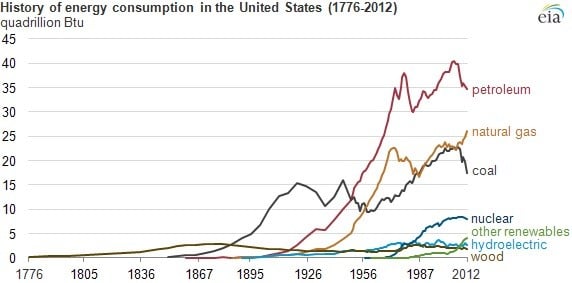How Energy Consumption Has Changed Since 1776
It’s easy to forget just how recently we started using fossil fuels in large amounts. In honor of the July 4 holiday, the U.S. Energy Information has produced a chart showing how rapidly the country shifted from using wood almost exclusively as an energy source to using first coal, then petroleum and natural gas.
Here’s a couple of notable things about the chart. The first is the obvious staying power of coal (see “The Enduring Technology of Coal”).
Coal doesn’t appear in significant amounts until the mid-1800s, but then use of this fuel increases quickly (and with it, overall energy consumption increases by about five times). When oil is introduced, it seems to displace coal, but coal use quickly recovers. A similar drop occurs when natural-gas consumption starts to rise. But within a couple of decades coal use is growing again.

Near the end of the chart, coal use drops off again as natural-gas production surges—a result of fracking technology. What the chart doesn’t show is that the EIA expects coal consumption to go up again this year. The stuff is cheap, and we seem to keep finding ways to use it. President Obama recently praised the reduction in carbon dioxide emissions due to the surge of natural-gas production (see “A Drop in U.S. CO2 Emissions” and “Obama Orders EPA to Regulate Power Plants in Wide-Ranging Climate Plan”). Given the resilience of coal, though, it’s hard to be optimistic that the decreased rate of emissions will persist—absent new regulations.
One other interesting bit. Renewables such as wind and solar power now produce more energy than was consumed in the mid-1800s. So if we want a society that runs completely on these renewables, all we have to do is reduce the population to what it was then, use only as much energy as 19th-century Americans did, stop flying airplanes (big ones require oil), stop industrial processes that require energy in forms other than electricity, and rely on electric vehicles or horses for transportation. I may have left something out.
The good news is renewables are increasing fast. But if history is a guide, the introduction of a new energy source doesn’t cause the other sources of energy to decrease, at least not in the long run. Even wood consumption is close to what it was in the 1800s, even though it’s less convenient in many ways that fossil fuels. Introducing new sources of energy seems to allow overall energy consumption to increase.
Absent regulations or political crises that cause the cost of fossil fuels to rise, we’ll use renewable energy more as technology makes it cheaper, but we’re likely to keep using more of the other sources of energy, too.
Indeed, the EIA predicts that in 2040, 75 percent of U.S. energy will still come from oil, coal, and natural gas.
Deep Dive
Climate change and energy
The problem with plug-in hybrids? Their drivers.
Plug-in hybrids are often sold as a transition to EVs, but new data from Europe shows we’re still underestimating the emissions they produce.
Harvard has halted its long-planned atmospheric geoengineering experiment
The decision follows years of controversy and the departure of one of the program’s key researchers.
Why hydrogen is losing the race to power cleaner cars
Batteries are dominating zero-emissions vehicles, and the fuel has better uses elsewhere.
Decarbonizing production of energy is a quick win
Clean technologies, including carbon management platforms, enable the global energy industry to play a crucial role in the transition to net zero.
Stay connected
Get the latest updates from
MIT Technology Review
Discover special offers, top stories, upcoming events, and more.